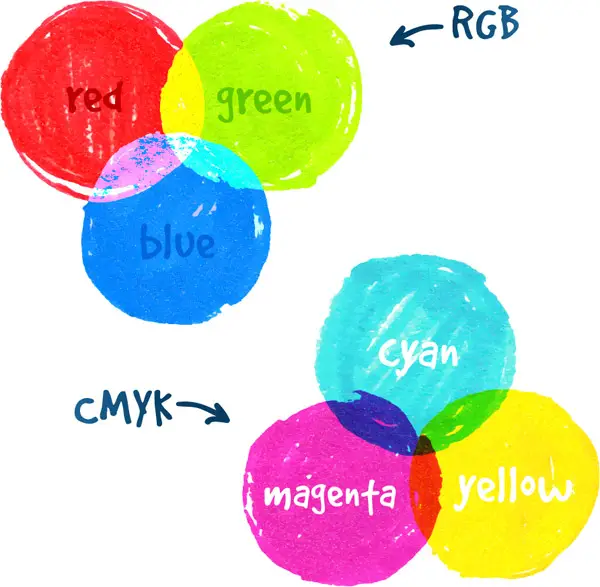Have you ever printed something and noticed the colors on the page look different than what you see on the screen? I know some people who’ll take the print and hold it next to the screen and say, “What’s wrong with my printer? Why don’t the colors match?” We in the print world deal with color issues on a daily basis and this blog will help address some of these issues.
Have you ever gone into a store that sells televisions or computer monitors, and noticed that the images on the screens vary greatly from each other, even though the display devices are receiving the same information? In a similar way to display devices, with print, there are many factors that play a role in determining what the final outcome of print will look like, even when starting with the same file. These factors include: file design, pre-press, print production, finishing and environment. Today I’m going to cover the first issue listed: file design. My objective is to explain the components in basic terms, so hopefully someone who’s not an expert in the print business can understand what is happening and the choices at they have at their disposal to get the visual aesthetic they hope to achieve on future print pieces.
Vector vs Raster
The basic thing to know about file design is that the program file type is not as relevant as the formula of information it generates. Any print shop worth their salt can open pretty much any file type you throw their way. Each of these programs create either vector or raster files, written in RGB or CMYK values. Knowing what color profile and what type of language your design program generates can help you communicate more effectively with your print provider, especially if you deal with multiple vendors.
Vector files are composed of mathematical equations that summarize what you see on the screen. These equations help reduce file size, but also allow for easy scaling both up and down. This is relevant primarily in sign printing and graphics printing for wrapping things such as walls and vehicles. One down side to vector files is that you can’t view them without a vector program. Designers have to convert the files to PDF, JPEG or something else for most end users to view the files electronically.
On the other hand, raster images don’t implement equations at all, but utilize a series of individual pixels or dots. Raster images can be easily shared and displayed by everyone with a computer, tablet or smart phone. The limiting factor of pixels comes in the form of scaling. Generally, you can almost always reduce in size a raster image without issue, but you are extremely limited to how far you can increase their size. If you try to scale up too far, you’ll start to notice the spaces between the pixels commonly referred to as pixilation. The further you scale up from 100% of original size, the more pixilated the image will become.
It is important to note that even when using a vector program, if you import a raster image as a component in the design, that part of the file is still raster unless you vectorize it. There are raster to vector and vector to raster conversion programs available if you run into this problem often. This matters because if you are trying to enlarge a vector file designed at 4x6 to say 24x36 the end result can still be pixilated for any of the components that have a raster source.
RGB vs CMYK
Have you ever noticed that most screens are black or dark when they are turned off and that most paper or items we print on are white when they are blank? Most people don’t notice that, however, now as you look around, you’re probably thinking, “how did I not notice that before?” Screens are dark because they use RGB (Red-Green-Blue) colors to produce the image. RGB is an additive system. The more color you add, the brighter it gets. In fact, to create white in RGB you simply mix all the colors together. When viewing data on a screen two things are happening simultaneously, first the data comes into the screen and second the settings of the monitor either fixed or end user adjusted are applied. Because of this, files you view on your computer will vary if you were to look at the same image using a separate monitor or if you were to open the file on a different computer. Fortunately, and unfortunately what this means is matching the screen view for a print shop is almost impossible. The print file is actually not related in any way to what you view on the screen. It all ties back to the values created by the design program.
Most paper is white, and that isn’t random; it serves a purpose. The image you view on your screen is derived from RGB. However, when it prints, it will most likely be converted by software (RIP) to CMYK (Cyan-Magenta-Yellow-Black) — a subtractive system. The difference is like night and day, since the screen is dark but the paper is bright; and at the same time has forced the methods in expressing color to be the opposite of each other. The paper starts out as bright as possible, so the ink added to the paper subtracts from the brightness which creates the desired color which happens to darken the page. The more colors you mix the closer to black you get. In CMYK the blank space is white and the space completely full of mixed inks is black. The values used to create an image on the screen are very different from most print devices because of the RGB to CMYK difference.
Other Basics to Know and Conclusion
The conversion process can play a large role in what you see. Have you ever written something in English and then used a translator program to rewrite it for you in another language? I’ve written in English and had a translation program convert to both Spanish and Russian to communicate with friends and family. The results they tell me are sometimes quite different than what I’d intended. Any time you translate there can be issues. Translation from the RGB to CMYK is no different. Beyond conversion issues, there are also many different (thousands of) devices that produce print as well. Some factors we just don’t have time to review include: toner vs. ink, 4 color versus 6, 8, 10, 12 color devices, the use of pantone and PMS colors, digitally run versus offset press run print, missing references or links and so much more.
When color matching matters, my advice would be to always get a hard proof. Only accept PDF proofs when the content (facts and figures) is what you’re really after and the colors don’t need to be anything specific. If you’re looking to have printed pieces match existing work or fit into a multifaceted campaign; you want to make sure you see the hard proof, or go to the print shop for a press check. The operator of the print device can’t know what the image looked like on your screen and much of color is personal preference in the eye of the beholder. Another solution is to give the print shop a physical go by to match. Knowing what affects color can help you achieve that end result more consistently. If you have a printed piece that is most sensitive and that you consistently are printing on one device, you can work towards setting color profiles to match. In fact, color profiling is one of the best ways to help reduce guess work. We live in a colorful world. It’s hard to know everything about everything but if you focus on the basics reviewed in this blog you should be happier with the colors on your printed materials.





